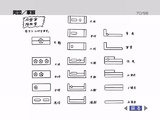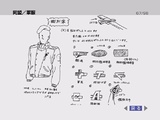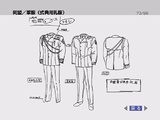Military ranks of the Free Planets Alliance
From Gineipaedia, the Legend of Galactic Heroes wiki
The military ranks of the Free Planets Alliance are a system of hierarchical titles used to indicate position and stature within the Alliance military. One ranking system applied to both space and ground forces, and ground forces were considered the more junior arm of the military due to the dominance of space warfare. Different service branches were indicated also with the use of pins on the left chest. The captain of a ship had a tricolor pin and officers commanding squadrons or fleets had an orange kerchief on their left chest. There was a tradition of posthumous promotion of two ranks for personnel killed in battle, which presumably would also affect pensions paid to their family.
Ranks
Spaceman Second Class
The insignia of a spaceman second class (Japanese: 二等兵 nitōhei) consisted of a collar pin with 1 bar.
It is the entry-level rank for drafted or volunteer enlisted members. It is in this phase of their career when recently inducted enlisted members will receive basic military training and follow up specialized training depending on their branch and rating. After their training is complete they will form part of the operational Fleet or Ground forces under the direct supervision of experienced non-commissioned officers.
Spaceman First Class
The insignia of a spaceman first class (Japanese: 一等兵 ittōhei) consisted of a collar pin with 2 bars.
Able Spaceman
The insignia of an able spaceman (Japanese: 上等兵 jōtōhei) consisted of a collar pin with 2 bars and one half bar.
Leading Spaceman
The insignia of a leading spaceman (Japanese: 伍長 gochō) consisted of a collar pin with 2 bars and one half bar, and a 'dot' towards the front.
Petty Officer Second Class
The insignia of a petty officer second class (Japanese: 軍曹 gunsō) consisted of an L shaped collar pin.
Petty Officer First Class
The insignia of a petty officer first class (Japanese: 曹長 sōchō) consisted of an L shaped collar pin with a 'dot' towards the front.
Warrant officer
The insignia of a warrant officer (Japanese: 准尉 jun'i) consisted of a collar pin with a half-field (and no other emblems).
Warrant officers are classified as lower class officers that have specialized technical skills in their area of expertise, different from regular officers who receive just general fleet or ground operations training. They usually rise from the enlisted ranks, gathering through their career a vast amount of technical knowledge regarding equipment or branch services.
Ensign
The insignia of an ensign (Japanese: 少尉 shōi) consisted of a collar pin with a half-field and a single 'dot' towards the front.
Examples:
- Ensign Franz Valleymunt (796 UC (487 IC / 3596 CE))
The lowest officer commission rank in the Alliance Fleets. This is an entry level rank for academy or combat commissioned officers. They do not hold much command responsibilities but are expected to develop and learn from senior officers. Most of them served as junior staff officers in the different fleet sections, as members of a ship's department or as spacecraft pilots. In ground units, the equivalent rank is Second Lieutenant.
Sub-lieutenant
The insignia of a sub-lieutenant (Japanese: 中尉 chūi) consisted of a collar pin with a half-field and a single horizontal 'dash' towards the front.
Examples:
- Sub-lieutenant Frederica Greenhill (796 UC (487 IC / 3596 CE))
The second lowest officer commission rank in the Alliance Fleets. This is a progressive level rank for academy or combat commissioned officers. They hold little command responsibilities and are expected to develop and learn from senior officers. Sub lieutenants are supposed to finish their post-commission training around this time of their career. Most of them served as junior staff officers in the different fleet sections, as members of a ship's department or as spacecraft pilots. In ground units, the equivalent rank is First Lieutenant.
Lieutenant
The insignia of a lieutenant (Japanese: 大尉 taii) consisted of a collar pin with a half-field, a single horizontal 'dash' towards the front, and a single 'dot' towards the back.
Examples:
- Lieutenant Frederica Greenhill (796 UC (487 IC / 3596 CE))
The third officer commission rank in the Alliance Fleets. This is the senior entry level rank for academy or combat commissioned officers. They hold some command responsibilities and are expected to command sections and learn from more senior officers. Lieutenants are supposed to develop their ship and troop command knowledge by this time in their career. Most of them served as senior staff members in their ships' departments or as spacecraft pilots. They can also serve as junior staff members in numbered fleet departments or as the ship executive officer in smaller ships like destroyers, support vessels or engineering craft. Lieutenant can command company size ground units, space-fighter squadrons or act as junior instructors at the academy or fleet courses. A naval Lieutenant is equal to a land Captain.
Lieutenant commander
The insignia of a lieutenant commander (Japanese: 少佐 shōsa) consisted of a collar pin with a border on each end and a single 'dot' towards the front.
Examples:
- Lt Commander Jean Robert Lapp (796 UC (487 IC / 3596 CE))
The first field officer rank in the Alliance forces. This is the junior field grade level rank for fleet and ground command officers. They hold command responsibilities and are expected to lead sections,ships and ground units. Lieutenant commanders are supposed to master their ship and troop command knowledge by this time in their career. Most of them served as department heads of capital ships, small spacecraft squadron commanders or as junior staff members in FPA wide departments. They also serve as ship second officers in battleships and carriers, executive officers in cruisers or as commanders of destroyers, personnel/cargo transports, engineering ships. The ground rank equivalent to a naval Lieutenant Commander is Major.
Commander
The insignia of a commander (Japanse: 中佐 chūsa) consisted of a collar pin with a border on each end and a single horizontal 'dash' towards the front.
Examples:
- Commander Dusty Attenborough (796 UC (487 IC / 3596 CE))
The mid-level field officer rank in the Alliance forces. This is the backbone field grade rank for fleet and ground officers. They can hold command responsibilities and are expected to lead sections, ships and ground units. Commanders are supposed to exercise full command authority on their ships and troops by this time in their career. They can serve as a flagship's second officers or executive officers in battleships/carriers. Commanders can also be commanders of cruisers or command destroyer squadrons, personnel/cargo transports groups and engineering ships squadrons. The land equivalent rank for a Commander is Lieutenant Colonel and can lead battalion size formations.
Captain
The insignia of a captain (Japanese: 大佐 taisa) consisted of a collar pin with a border on each end, a single 'dash' towards the front, and a single 'dot' towards the back.
Examples:
- Captain Jean Robert Lapp (posthumous — 796 UC (487 IC / 3596 CE))
The senior-level field officer rank in the Alliance forces. They hold command responsibilities and are expected to direct fleet departments and command ships or ground units. Most of them serve as heads of the numbered fleets departments, as small spacecraft wing commander, and mid-level staff members in the FPA wide departments. They can also serve as ship commanding officers in battleships, carriers or flagships. Senior captains can command squadrons of battleships, carriers, battlecruisers or cruisers if a commodore is not available to fill the position. In ground units a naval captain which is equal to a Colonel can command a regimental size ground force.
Commodore
The insignia of a commodore (Japanese: 准将 junshō) consisted of a collar pin with no borders and a two horizontal 'dashes'.
Examples:
- Commodore Murai (796 UC (487 IC / 3596 CE))
- Commodore Yang Wen-li (796 UC (487 IC / 3596 CE))
Commodore is the most junior flag officer rank in the Alliance Fleets. This is the lowest fleet commander level rank for Alliance officers. They are expected to command departments, ship squadrons and ground units. Most of them serve as department heads in fleets, as a numbered fleet small spacecraft wing commander, and as mid-level staff members in the FPA wide departments. They also work as commanding officers in flagships. Commodores can command squadrons of battleships, carriers, battlecruisers or cruisers that form part of a numbered fleet wing or of an independent squadron. In ground units a naval Commodore which is equal to the rank of Brigadier General can command a brigade size ground force.
Rear admiral
The insignia of a rear admiral (Japanese: 少将 shōshō) consisted of a collar pin with no borders and a single pentagonal Alliance emblem towards the front.
Examples:
- Read Admiral Edwin Fisher (799 UC (1 NIC / 490 IC / 3599 CE))Deputy Commander, FPA 13th Fleet.
- Rear Admiral Alex Cazerne (796 UC (487 IC / 3596 CE))Rear Support Chief, FPA.
- Rear Admiral Arthur Lynch (788 IC (299 NIC / 1097 UC / 3897 CE))Comander FPA Garrison in El Facil Starzone.
Rear Admiral is the second most junior flag officer rank in the Alliance forces. This is the backbone flag rank for Alliance officers. They hold command responsibilities and are expected to command independent ship squadrons and large ground units. Rear Admirals are supposed to exercise full command authority over their squadron and troops. Most of them serve as a numbered fleet wing commander and high-level staff members in the FPA wide departments. Rear Admirals can command numbered fleet wings or independent squadrons or serve as deputy commanding officers for Alliance numbered fleets. In ground units a naval Rear Admiral which is equal to a Major General can command a reinforced brigade size ground force.
Vice admiral
The insignia of a vice admiral (Japanese: 中将 chūjō) consisted of a collar pin with no borders and two pentagonal Alliance emblems towards the front.
Examples:
Commander FPA 1st Fleet (799 UC). Commander FPA 2nd Fleet (797 UC).
- Vice Admiral Ralph Carlsen (800 UC (2 NIC / 491 IC / 3600 CE))
Commander FPA 15th Fleet (800 UC)
Vice Admiral is the mid-level flag officer commission rank in the Alliance forces. They expected to command the Alliance's numbered fleets and large ground formations. Vice Admirals are supposed to exercise full command authority on their Alliance numbered fleets and troops. Most of them serve as department heads in combined fleets, as FPA's numbered fleet commanders, and as department chiefs in the FPA wide departments. In ground units a naval Vice Admiral which is equal to a Lieutenant General can command a division size ground force.
Admiral
The insignia of an admiral (Japanese: 大将 taishō or 提督 teitoku) consisted of a collar pin with no borders and three pentagonal Alliance emblems.
Examples:
- Admiral Dwight Greenhill (796 UC (487 IC / 3596 CE))
- Admiral Yang Wen-li (797 UC (488 IC / 3597 CE))
Admiral is the senior level flag officer commission rank in the Alliance Fleets. This is the senior theatre front commander level rank for Alliance officers. They hold command responsibilities and are expected to command Alliance combined fleets and ground units. Most of them serve as Alliance expeditionary force commanders and as the chief of staff in the Alliance fleet. In some cases the defence ministry might appoint a Admiral to oversee a strategic sector of space. In ground units a naval Admiral which is equal to a General can command a corps size ground force.
Fleet admiral
The insignia of a fleet admiral (Japanese: 元帥 gensui) consisted of a collar pin with no borders, a horizontal line across the middle, and single pentagonal Alliance emblem in the centre.
Examples:
- Fleet Admiral Sidney Sithole (796 UC (487 IC / 3596 CE))
Fleet Admiral is the highest level flag officer commission rank in the Alliance Fleets. They are appointed as supreme commanders of the various Alliance forces commands. They hold command responsibilities and are expected to lead the entire Alliance forces. Most of them served as commanders of combined fleets, as the Alliance Joint Operations Headquarters Chief, and as the Free Planets Star Fleet supreme commander. In ground units a naval Fleet Admiral which is equal to a General of the Army can command the Alliance Ground force branch.














